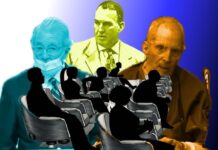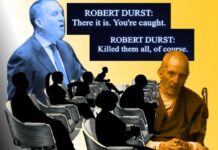The Prosecution in the murder trial of Robert Durst is trying to convince the jury beyond a reasonable doubt that Durst killed his longtime friend, Susan Berman — as well as his Galveston neighbor, Morris Black — in order to cover up his alleged murder of his ex-wife, Kathie.
Lead Prosecutor John Lewin and his team are not only preparing the members of that panel to accept this as the most compelling and logical narrative but also want the jurors to feel the pain and cruelty they say Durst inflicted on those closest to him — and to viscerally understand the real-life consequences of his misanthropy.
When Deputy DA Habib Bailian calls Virginia McKeon to the stand, she adds to this compilation of personal testimony that the Prosecution has woven together in a series of striking, richly specific, and emotional narratives in the Durst saga.
Crime Story has already covered a number of those narratives. Kathryn Shaw-Cutter humanized her otherwise eccentric neighbor, Susan Berman, by talking about Berman’s devotion to her dogs. Shaw-Cutter also relayed how she came to share that affection, eventually adopting one of the dogs, Lulu, after Berman’s death. Then there was Ann Doyle, who offered that she had decided to travel halfway around the world amid a mushrooming pandemic in order to speak to the trauma that her friend Kathie Durst had suffered at the hands of Robert. Another friend, Marion Watlington, waited 40 years to be able to relate the marital horrors that Kathie shared with her. She also shared Kathie’s plea with the jury, “Don’t let the bastard get away with it.” Of course, Thomas Durst, Robert’s own brother, provided an explosive testimony describing the trauma-inducing passion of his brother’s cruel and abusive behavior. And Kathie’s brother Jim, the eldest of the five McCormack siblings, testified of his love for his baby sister and the agony of helplessly witnessing her husband physically abuse her in the McCormack family home.
Virginia McKeon’s testimony is the last of these emotional narratives to be heard in Judge Windham’s courtroom before the trial is suspended due to the Covid19 pandemic. For McKeon, the courtroom is a memory box of complex emotions that brings her long lost sister, Kathie Durst, back to life — but in the worst imaginable way.
BALIAN: WHAT WAS IT LIKE, BEING A MCCORMACK, GROWING UP?
MCKEON: IT WAS GREAT. WHEN I LOOK BACK, WE HAD A REGULAR, HAPPY MIDDLE-CLASS FAMILY. MY DAD WENT TO WORK AND MY MOM WAS ABLE TO BE HOME WITH US, YOU KNOW, TO RAISE US. SO WE HAD A REALLY NICE TIME. WE PLAYED AND, YOU KNOW, WE WERE CLOSE AS CAN BE WHEN, YOU KNOW SIBLINGS AND, YEAH, IT WAS A NICE FAMILY.
Early on in his questioning, Balian uses humor to draw emotion out of his witness. We saw this when he guided Sandra Garfield to describe how Susan Berman’s dog, the lovable but incorrigible Lulu, ripped up her carpet. Here, he asks McKeon to describe the McCormack family home.
BALIAN: YOUR PHYSICAL PROXIMITY TO EACH OTHER, GROWING UP, HOW BIG WAS THE HOUSE YOU GUYS LIVED IN?
MCKEON: IT WAS A THREE BEDROOM HOUSE. IT WAS A NICE HOUSE. YOU KNOW WE WERE IN BROOKLYN UNTIL I WAS FOUR, SO I DON’T REALLY REMEMBER A WHOLE LOT OUT THERE. BUT WHEN WE MOVED TO HOLLIS, IT WAS A NICE HOUSE, THREE BEDROOM. JIM HAD ONE ROOM AND MY PARENTS AND THEN THE FOUR GIRLS WENT INTO ONE ROOM.
BALIAN: FOUR GIRLS SHARED ONE ROOM AND JIM HAD HIS OWN ROOM? THAT DOESN’T SEEM RIGHT. HOW MANY BATHROOMS WERE THERE?
MCKEON: JUST ONE. BUT AT THAT TIME, I DON’T KNOW, IT WASN’T A MAJOR ISSUE THAT I RECALL ANYWAY. YOU KNOW, WE ONLY HAD TWO CLOSETS, BUT IT WAS ENOUGH, AS I SAID, WE WERE ALL HAPPY.
Under Balian’s guidance, McKeon describes her family as middle-class, fun-loving people who never seemed to take life too seriously, people with whom anyone can empathize. In showcasing for the jury the relatability of Kathie and her family, the Prosecution also seeks to alienate them from Robert Durst.
BALIAN: WHAT TYPES OF THINGS GROWING UP, WHAT’D YOU GUYS DO TOGETHER AS A FAMILY?
MCKEON: OUR RELATIVES DIDN’T LIVE TOO, TOO FAR AND SO WE’D GET TOGETHER FOR SUNDAY DINNERS AND, YOU KNOW, JUST OUTINGS AND IT WAS A GOOD THING. IT WAS, YOU WEREN’T AS MOBILE AS YOU ARE TODAY, SO YOU KNOW, TO GO TO A PARK OR A PICNIC OR SOMETHING WAS REALLY A TREAT. SO WE’LL DO THINGS LIKE THAT WITH THE RELATIVES MAINLY JUST, YEAH, THAT TYPE OF THING. AND THEN, UM, WE’RE VERY LUCKY, LIKE IN THE SUMMERTIME WE GOT TO GO UP TO THE LAKE. MY GRANDMA HAD A CABIN, TWO CABINS UP IN THE POCONO’S AND SO WE GOT TO GO UP THERE FOR USUALLY A MONTH DURING THE SUMMER WHICH WAS REALLY A TREAT.
—————–
BALIAN: HOW CLOSE WAS KATHIE TO YOUR MOTHER?
MCKEON: LET ME SEE. WELL, I THINK THAT WAS MY MOM’S BABY. SO AGAIN, SHE WAS THE BABY AND SO I THINK SHE WAS VERY CLOSE.
—————–
BALIAN: WHAT WAS KATHIE LIKE GROWING UP?
MCKEON: SHE WAS SIX YEARS YOUNGER THAN I WAS. SO, YOU KNOW, WE WERE KIND OF IN, NOT DIFFERENT WORLDS, BUT YOU KNOW, THERE WAS SPACE. SHE WAS MY BABY SISTER AND SHE WAS, I CAN’T REMEMBER ANY MAJOR ISSUES OR, YOU KNOW, THAT TYPE OF THING. WE PLAYED.
BALIAN: WHAT WAS HER PERSONALITY?
MCKEON: WELL, HER PERSONALITY, SHE WAS — KATHIE — SHE JUST WAS SPECIAL. IT WAS SOMETHING ABOUT HER. SHE, SHE WAS REALLY INTELLIGENT. YOU KNOW, SHE WAS JUST BRIGHT. SHE LIKED TO TRY THINGS AND DO THINGS AND SHE WAS FUN TO BE WITH, YOU KNOW. SHE WANTED TO PLAY GUITAR SO SHE GOT A GUITAR AND SHE, YOU KNOW, SHE WOULD TRY THINGS. SHE LIKED TO SURF ON THE BEACH. SHE WOULD TAKE OFF WITH MY BROTHER AND GO SURF DOWN AT JONES BEACH AND THAT AREA.
—————–
Balian then shows the courtroom an old photo of the McCormack family, gathered together, care-free and joyful.
BALIAN: IT’S A PHOTOGRAPH. PEOPLE ARE SMILING, PEOPLE LOOK HAPPY, PEOPLE GENERALLY SMILE FOR PHOTOGRAPHS. BUT WHAT I WANT TO ASK YOU IS THESE PHOTOGRAPHS AND THE SMILES YOU SEE, ARE THESE FOR A CAMERA OR IS THIS REPRESENTATIVE OF WHAT YOUR FAMILY WAS LIKE?
MCKEON: AW, THAT’S THE WAY WE WERE. THAT’S THE WAY WE WERE? ALL-EASY SMILERS. WHEN WE SMILE. WE TEND TO, I THINK WE KIND OF LOOK A LOT ALIKE.
By putting the jury in the shoes of the McCormack’s, Balian has them in the perfect headspace for what comes next — our alleged killer, Robert Durst, entering the family.
BALIAN: WOULD YOU SEE HER AND ROBERT DURST TOGETHER IN THE BEGINNING OF THEIR MARRIAGE?
MCKEON: YEA.
BALIAN: HOW DID THEY SEEM?
MCKEON: THEY SEEMED FINE. THEY SEEMED HAPPY. I MEAN, YOU KNOW, HE WAS MY SISTER’S HUSBAND, SO, YOU KNOW, THEY SEEMED OKAY.
BALIAN: DID YOU WELCOME HIM INTO THE FAMILY?
MCKEON: OH SURE, YEA. THAT’S THE WAY WE ARE.
Robert Durst entered Kathie’s family like a square peg in a round hole. On the one hand, we’ve heard about the vast amount of love within the McCormack clan. On the other, we have a man whose own brother, Thomas Durst, just testified against him, explaining that his family stopped keeping touch decades ago.
BALIAN: DID THEIR RELATIONSHIP APPEAR TO YOU, FROM THE TIME THAT YOU SAW HER, CHANGE OVER TIME WITH ROBERT?
MCKEON: WELL SHE WAS REALLY HAPPY. SHE WAS IN LOVE. SHE WAS REALLY HAPPY WHEN SHE FIRST MET HIM. I KNOW SHE WAS. AND THEN GRADUALLY SHE, I THINK SHE WANTED MORE, SHE WANTED TO, YOU KNOW, TO ACCOMPLISH MORE. I THINK THIS IS WHAT HAPPENED WITH KATHIE. SHE WANTED TO ACCOMPLISH MORE AND SO, YOU KNOW, SHE WANTED TO GO TO NURSING SCHOOL AND THAT SEEMED TO CHANGE. THAT SEEMED TO ALTER THINGS A LITTLE BIT.
Balian then elicits from McKeon the sweet but somber memory of her final interaction with her sister.
BALIAN: YOUR SISTER DISAPPEARED ON JANUARY 31ST 1982, RIGHT?
MCKEON: YES.
BALIAN: WHAT WAS THE LAST TIME YOU SPOKE WITH HER PRIOR TO THAT?
MCKEON: IT WAS SOMETIME IN JANUARY, A COUPLE OF WEEKS BEFORE SHE, UM, WAS KILLED. AND SHE CALLED ME OR I CALLED HER, IT’S KIND OF FUZZY, BUT WE WERE ON THE PHONE FOR THREE HOURS. AND I CAN STILL REMEMBER PHYSICALLY, I WAS SITTING ON THE FLOOR — WE HAD JUST GOT A NEW APARTMENT AND THERE WAS NO FURNITURE — SO I WAS SITTING ON THE FLOOR TALKING TO HER FOR THREE HOURS. JUST TALKING.
DEGUERIN: I DIDN’T WANT TO INTERRUPT HER, BUT I’D LIKE TO STRIKE THE WORD “KILLED.” THAT WAS NOT RESPONSIVE.
WINDHAM: JUST A MOMENT, ALRIGHT I WILL STRIKE THE ANSWER AS NOT RESPONSIVE.
As McKeon utters the word “killed,” we are brought back to the reality that this is a murder trial. The Defense objects to her use of the word, and while Judge Windham sustains the objection, Balian digs deeper into the past to fully realize the emotional significance of that utterance.
BALIAN: HAVE YOU SEEN KATHIE SINCE JANUARY 31ST, 1982?
MCKEON: NO.
BALIAN: HAS SHE ATTENDED ANY OF THESE FAMILY CELEBRATIONS SINCE THAT DAY?
MCKEON: NO.
BALIAN: AND YOU CONTINUE TO HAVE THEM.
MCKEON: AS MUCH AS IT HURTS.
BALIAN: DID SHE ATTEND ANY OF THE MILESTONES IN YOUR KIDS’ LIVES OVER THE YEARS?
MCKEON: NO.
BALIAN: IF SHE WAS ALIVE, WOULD SHE HAVE BEEN THERE FOR YOUR CHILDREN DURING THEIR IMPORTANT TIMES NOW?
MCKEON: OH, SHE WOULD’VE, YES.
BALIAN: IF KATHIE WERE ALIVE, WOULD SHE HAVE ATTENDED YOUR MOTHER’S FUNERAL?
MCKEON: OH GOSH, YES.
BALIAN: IF KATHIE WERE ALIVE WOULD SHE HAVE ATTENDED YOUR BIRTHDAYS OR CALLED YOU ON YOUR BIRTHDAYS OR WROTE YOU A LETTER ON YOUR BIRTHDAY THROUGHOUT THE YEAR?
MCKEON: OH, I’M SURE SHE WOULD’VE.
BALIAN: IF KATHIE WERE ALIVE, WOULD SHE HAVE REACHED OUT AND HAD SOME FORM OF COMMUNICATION NO MATTER WHAT IT WAS THROUGHOUT THE YEARS TO LET YOU KNOW, “HEY, I’M OKAY AND I’M STILL OUT HERE.”
MCKEON: YES, I HAVE NO DOUBT.
BALIAN: DO YOU HAVE ANY DOUBT IN YOUR MIND THAT YOUR SISTER IS DEAD?
MCKEON: NONE.
McKeon’s voice is shaky as Bailian comforts her through his final questions. And — as Dick Deguerin rises to cross-examine this witness — feelings of sadness, longing, and fear hang in the air.
————————-
Robert Durst’s defense team so far seems to be deploying a strategy — at least in their opening statement and their cross-examinations — of trying to pick apart details of each of these witnesses’ emotional narratives.
In Durst’s previous murder trial (in Texas for the killing of Morris Black) Dick Deguerin, Chip Lewis, and others presented to the jury what Deguerin called a “poor little rich boy” narrative. Durst, they explained, had suffered the terrible trauma of not only witnessing his mother’s suicide as a child, but also growing up with an emotionally abusive father. And though Durst had admitted to dismembering Morris Black, his lawyers believed that a carefully crafted, sympathetic narrative could nudge the jury toward empathy for their client. In that context, they trusted the jury would be more inclined to believe that Durst killed Black not with malice but in self-defense.
How exactly the Defense counters the Prosecution’s representation of Durst as a cruel and ruthless misanthrope remains to be seen. But in the cross-examination of Virginia McKeon, DeGuerin only seeks to make one point…
DEGEURIN: YOU WERE RAISED BASICALLY ON THE EAST COAST. BROOKLYN, LONG ISLAND?
MCKEON: I WAS BORN IN BROOKLYN AND GREW UP ON LONG ISLAND.
DEGUERIN: WOULD YOU AGREE WITH ME THAT FOLKS THAT ARE RAISED ON THE EAST COAST, BROOKLYN, LONG ISLAND, NEW YORK CITY, HAVE A RATHER DISTINCTIVE ACCENT?
MCKEON: YES.
DEGUERIN: NOW SEE I DON’T THINK I HAVE AN ACCENT AT ALL. (LAUGHTER)
—————–
DEGUERIN: KATHIE TALKED THAT WAY TOO, DIDN’T SHE?
MCKEON: YEA. WE ALL DID.
DEGUERIN: ARE YOU FAMILIAR WITH A WEST COAST ACCENT?
MCKEON: I DON’T KNOW, I GUESS I DON’T THINK OF THEM HAVING AN ACCENT MAYBE. NOT LIKE THE SOUTHERN ACCENTS OR THE BOSTON ACCENTS.
DEGUERIN: BUT THAT’S THE WAY KATHIE TALKED?
MCKEON: YEA.
DEGUERIN: THAT’S ALL I HAVE.
With that, Deguerin is done. It seems the Defense cannot use McKeon’s testimony to paint Durst as a “poor-little-rich-boy” or elicit any kind of empathy from the jury. Instead, Deguerin tries to use McKeon to counter the Prosecution’s allegation that it was Susan Berman, pretending to be a sick Kathie Durst, who called the Dean of the Albert Einstein Medical School to cover up her disappearance the day after Robert Durst killed her. Berman’s motive, according to the prosecutors, was to give her friend Robert an alibi. Presumably, the Defense will ultimately ask the jury to infer that Virginia McKeon’s accent was similar to her sister’s, and that if it was Susan Berman who called the school, pretending to be Kathie, surely the Dean would have recognized that Berman sounded nothing like Kathie Durst.
The Defense has done nothing so far to rebut effectively the emotional testimonies that collectively depict Robert Durst as a cold and calculating man, capable of pathological cruelty. This leads us to a key question that will be at the heart of the Durst trial when it resumes: Can the defense find an effective counter-narrative that will cast doubt in the jurors’ minds of Robert Durst’s capacity to commit these three murders?
CRIME STORY has reported extensively on the Durst Trial, publishing more than 20 pieces on the case over the past year. You can find links to all of those stories here.






